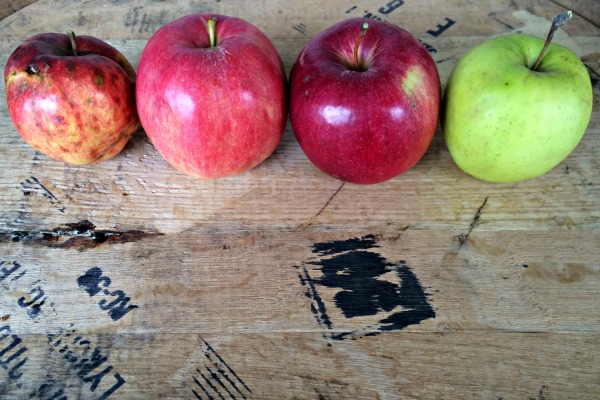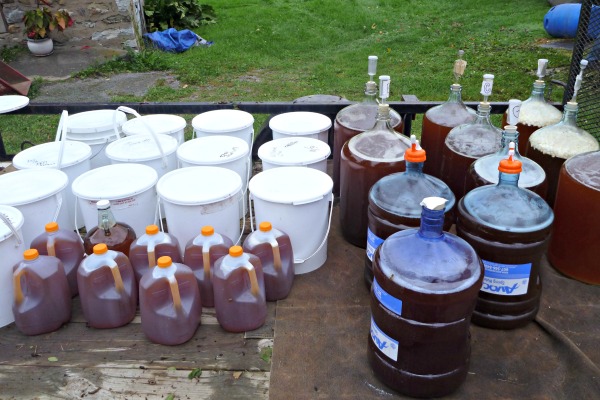
The Basics of Making Cider
Fruit/Juice selection
Characteristics that make an apple a delicious eating apple are not (always) the same things that make a good cider apple.
Dessert style apples are the types of apples people are most familiar with; they are the ones sold in all grocery stores and most readily available. These apples are often high in sugar. Think empire, macintosh, red delicious, honeycrisp, etc.
Usually when making cider you want a well-balanced blend of apples. High sugar varieties offer higher alcohol, you also want some acidity (think granny smith apple tartness) and tannin if available- cider specific apples, crab apples, or some wild apples if you can find them!
Juice- If you’re skipping choosing the apple blend you can go right to buying the fresh sweet cider. If you can find a farm stand that presses sweet cider, especially in the fall that is your best bet. Unpasteurized juice is best, UV pasteurized juice is ok. If you are buying cider at the store make sure no sorbate, potassium sorbate, or benzoate have been added.
Fermentation Supplies
- Cleaner/sanitizer
- Fermentation container (carboy, jug, bucket)
- Bubbler
- Yeast
- Thermometer
- Preferably a hydrometer as well
- and…these additives?
- SO2?
- Nutrients?
- Sugar?
Cleaning and Sanitizing:
Cider, winemaking, and brewing are, at least 75% cleaning….not as glamorous as most people think.
It is important to make sure you have a reliable cleaner and sanitizer. They are not the same thing.
Cleaning: The physical scrubbing of a vessel, hose, etc. to remove soil and debris.
Sanitizing: Reduction in microorganisms, or disinfecting. For sanitation to be effective the cleaner must do the majority of the work and there cannot be physical debris left over.
Small scale and homebrewers can find what they need on morewinemaking.com. When we started we were using PBW and Star San, but there are a whole slew of cleaning and sanitizing options. Most of the faults/flaws/infections found in cider can be attributed to dirty surfaces, so you MUST keep everything free of debris and sanitized.
Prior to fermentation you will want to check the sugar level in your sweet cider. You can also use a refractometer to give you a sugar reading. This tool is great to use in the field to measure sugar levels in the apples. It cannot be used once fermentation has begun because the alcohol will interfere with the light bending causing an inaccurate reading.
The best tool for a beginning cidermaker is a hydrometer. This measures the specific gravity of your juice and can be used throughout the entire fermentation process. The specific gravity is a measurement of the ratio of the density of the juice relative to the density of water. The dissolved solids that are causing an increase in density, and therefore specific gravity are 90-95% fermentable sugars- so a measurement of specific gravity will give you a close estimate to what the final alcohol of your cider will be.

Fermentation Vessels:
Next you have to choose what you will ferment in.
Stainless steel is, of course, the most ideal vessel for fermentation because of many factors. On a small-scale glass works almost as well. Of course, once you ferment more than 6 gallons at a time, glass becomes quite impractical. There is a huge debate between fermenting in plastic and fermenting in stainless steel, but it might come down to cost…and plastic will always be more affordable.
Bubbling Away:
C6H12O6 → 2 C2H5OH + 2 CO
Yeast +Sugar → Alcohol + Carbon Dioxide
As yeast metabolizes sugar and produce alcohol, they will also produce carbon dioxide, this means your vessel cannot be completely sealed (or it will blow!). A bubbler on top of a carboy or a hose into a bucket works well for the carbon dioxide off-gassing. During primary fermentation you can leave a bit of headroom in the vessel because the fermentation will be producing enough CO2 to protect the liquid.
Next we will look at controls during fermentation.
